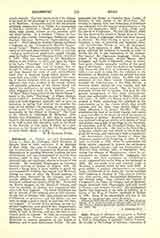

Ailly, PIERRE D’ (PETRUS DE ALLACO), a French theologian and philosopher, bishop and cardinal, b. 1350 at Compiegne; d. probably 1420 at Avignon. He studied at the College of Navarre, University of Paris. In 1375, by his commentaries on the Sentences of Peter Lombard, he furthered the cause of Nominalism in the University of Paris. He received the degree of Doctor of Theology in 1380. At that time he wrote several treatises, in which he maintained, among other doctrines, that bishops and priests hold their jurisdiction from Christ, not from the Pope, that the Pope is inferior to a general council, that neither the Pope nor the council is strictly infallible, but only the universal Church. In 1384 he became director of the College of Navarre; Gerson and Nicholas of Clemanges were among his pupils. He acquired great fame by his sermons, writings, and discussions. The University having censured several propositions of the Dominican John of Monzon, who denied the Immaculate Conception of the Blessed Virgin, the latter appealed to Clement VII. In behalf of the University, d’Ailly was sent to Avignon as the head of a delegation, and finally (1389) persuaded Clement to maintain the condemnation. The same year d’Ailly was made Chancellor of the University, Confessor of the King, and Treasurer of the Sainte Chapelle. When Benedict XIII succeeded Clement VII at Avignon, d’Ailly’s influence caused him to be recognized at the French court. He was appointed Bishop of Le Puy in 1395, and in 1397 Bishop of Cambrai. He was very active in trying to solve the principal question of the day, the ending of the great schism. He proposed the assembling of a general council—an idea which he had suggested in a sermon as early as 1381—and endeavored to bring the two Popes to resign. On account of Benedict’s hesitations and false promises, d’Ailly withdrew more and more from the Avignon Pope, and when, in 1398, the French King recalled his submission, d’Ailly approved this action. Later, however, he counselled obedience, though only in essential matters, and this course having been accepted by the Council of Paris, he announced it in a sermon in the Church of Notre Dame (1403). At the Council of Aix (January, 1409) d’Ailly again advocated the necessity of a general council. The unity of the Church, he claimed, does not depend on the unity of the Pope, but on that of Christ. The Church has a natural and divine right to its unity and self-preservation; hence it can, even without the Pope‘s sanction, assemble in a general council. A few months later, in fact, the Council of Pisa was convoked, in which both Popes were deposed, and a third, Alexander V, was elected, thus complicating the difficulty. In 1411 d’Ailly was made cardinal by Alexander‘s successor, John XXIII, and assisted at the Council of Rome (1412). In 1414 the Council of Constance was convoked, and was successful in ending the schism by the election of Martin V (1418). D’Ailly took a leading part in the council and presided at its third session (March 26, 1415). He insisted on several principles, some of which had been developed already in his earlier writings. The council, he said, having been duly convoked, could not now be dissolved by any action of the Pope; as its power came from Christ immediately, all the faithful, and the Pope himself, were obliged to submit to its decisions. He favored the method of voting by nations and the extension of the power of voting to the doctors of theology and of canon law, and to the princes and their legates. These were complete departures from the practice of the Church. After the Council of Constance, d’Ailly was appointed by Martin V legate at Avignon, where he died.
D’Ailly enjoyed considerable celebrity among his contemporaries, who gave him the titles of Aquila Franciae, et aberrantium a veritate malleus indefessus (The eagle of France and the indefatigable hammer of heretics). If his principles concerning the power in the Church are exaggerated—and, in fact, they have been condemned since—they should be considered with reference to the condition of those times when the Church was divided under two heads. In many respects d’Ailly reproduces the theses of Occam and the Nominalists, that the existence of God cannot be strictly demonstrated, that the doctrine of the Trinity cannot be established from the Scriptures, that positive law is the only basis of morality, etc. In many instances he shows a tendency to mysticism. His works are numerous (154); some of them have not yet been published. Besides those that have reference to the schism and the reformation of the Church, others treat of Holy Scripture, apologetics, asceticism, theology, philosophy and the sciences. He was a believer in astrology, and in his “Concordance of Astronomy with History” he attempts to show that the dates of the main events of history can be determined by astronomical calculations. In his “Imago mundi” he taught the possibility of reaching the Indies by the West, and in confirmation of his own reasoning he alleged the authority of Aristotle, Pliny, and Seneca. D’Ailly’s views were useful to Columbus and encouraged him in his undertaking. [Cf. La decouverte de l’Amerique et Pierre d’Ailly, by Salembier, in “Revue de Lille“, 1892, V, 622-641.] Columbus had a copy of the “Imago mundi”, on the margin of which he had written many notes with his own hand, and which is still to be seen in the Columbine Library at Seville. In another of Columbus’s books, the “Libro de las profecias”, are to be found many notes taken from d’Ailly’s works on cosmography. Hence Las Casas (Historia de las Indias, vol. I, xi, 89) says that of all “modern” writers d’Ailly exercised the greatest influence on the realization of Columbus’s plans. His dissertation on the reformation of the calendar, composed in 1411, and read at the Council of Constance in March, 1417, was later accepted and completed by Gregory XIII.
C. A. DUBRAY

